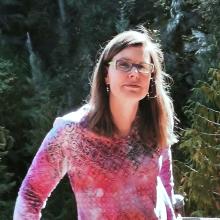Sara Billey and and her collaborator Tímea Tihanyi from the School of Art, Art History and Design are the 2018 recipients of the UW College of Arts and Sciences’ Bergstrom Award for Art and Science. The award, given annually, is intended to support faculty projects “that enhance the student experience and bridge the intersection between art and science.” Sara and Tímea have collaborated on several projects over the years, and Tímea has collaborated as well with Sándor Kovács (co-teaching a Discovery Seminar on art and mathematics for incoming students) and Jayadev Athreya (via a Simpson Center collaboration grant).
For their Bergstrom-funded project, Sara, Tímea, and math major/intern, Daria Micovic, will continue their work on discrete mathematical algorithms that output two- and three-dimensional tactile patterns for realization in 3D printed ceramics. They will also engage students at many different stages of their education through extended research and internship opportunities, public lectures, social media, and a print publication. The following passage from their proposal captures the spirit of their collaboration:
We’ve successfully developed a process for transcribing Sage-generated images into computer-aided designs (CAD) using Rhino, Meshmixer, and Simplify3D. Following the prescribed path of coordinates, the ceramic 3D printer extrudes a thin coil of soft plastic porcelain. As a result of the ceramic process from printing to firing, the rigorous geometry of the design goes through an amazing transformation. Due to the material qualities of clay, objects made on the clay printer would not exist and often enough cannot stand without the human hand. The exposure to vitrification temperatures in the kiln, glazing, and surface treatments soften the forms, create “blips,” inconsistencies, and unrepeatable surprises. Clay shares a key ingredient, silica, with semiconductors. Various impurities and changes to the algorithm of its basic chemical structure make each material: the humble dirt that makes vessels for the body and the nearly immaterial piece of technology that mediates most aspects of our daily lives. Potters refer to the intelligence of clay, a “memory” by which it remembers its former states and a “personality,” which requires a deep understanding of the material through craft. Between algorithm and serendipity lies the resulting 3D printed clay object, logical yet unpredictable.
Sara Billey is co-recipient of A&S Bergstrom Award
Submitted by Rose Choi
on

